Render Farm Price: Guide for 5 Best Render Farms
You want to outsource the render because your computer is rendering so slowly. You go online looking for render services and compare render farm price. But you are confused with the whole GHzH, Obh, core hour and node hour thing. You don’t know how to compare and find the most reasonable price. Then this article is for you. Go with VFXRendering to understand the basic pricing units and how our Top 5 Render Farms calculate render cost.
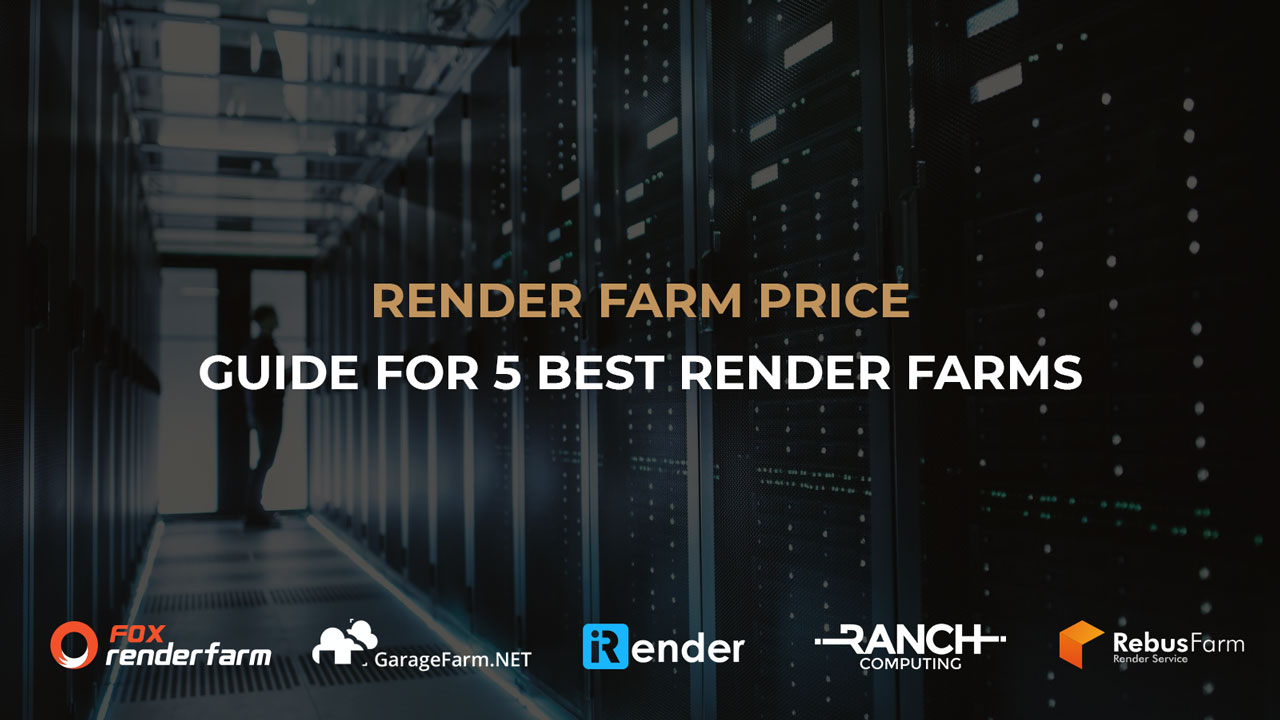
Table of Contents
How does render farm price work?
Each render farm may use different pricing methods to charge its users. But in general, there are four units: GHzH, Obh, core hour and node hour.
What do they mean? Let’s find out below.
What is GHz hour?
GHzH or GHz hour stands for Gigahertz per hour. It is the basic unit of CPU cost calculation. GHz hour is a price for 1 Ghz used in an hour of rendering.
Still vague? Okay, let’s take an example.
Let’s say you have a computer with one CPU. This CPU has just one core and runs exactly at 1 Ghz. You render a project on this computer, and it takes just 1 hour to finish. In this case, the project uses 1 Ghz-hour. If a render farm charges $1 per GhzH for this computer, the expense for this project will be $1 per GhzH.
Of course, this example is just to make it easy for you to understand the concept of Ghz hour. Modern CPUs have several cores and run at more than 1 Ghz clock speed. Let’s take a real one:
Intel Xeon E5-2699 v4 has 22 cores and runs at 2.20 Ghz. A render farm running Intel Xeon E5-2699 v4 computer charges $0.015 per Ghz hour. So, a project rendering for 1 hour on this one machine will cost 22 x 2.2 x 0.015 x 1 = $0.726. ($0.726 is the price per node hour of Intel Xeon E5-2699 v4 node, we will look further in the ‘node hour’ section).
In short, GHzH is a way to calculate the cost of CPU-based render farms for one hour. It means we take the GHz of all the nodes that were used in rendering a job. Then we multiply that total by the GHzH rate of the render farm.
Render cost = Number of cores x Clock speed (Ghz) x Price per GHz hour x Render time
In addition, GhzH method is widely used by render farms around the world, including GarageFarm, RANCH Computing and RebusFarm.
What is core hour?
Core hour is similar to GHz hour, and is also used for CPU-based rendering. Instead of calculating based on the clock speed of each core (GHz), we will use the cores of processor. Now the math becomes easier:
Render cost = Number of cores x Price per core hour x Render time
For example, a render farm charges $0.06 per core hour. So, rendering on 16-core CPU node for 1 hour will cost 16 x 0.06 x 1 = $0.96. Similarly, 24-core CPU node costs $1.296/hour while 28-core CPU node charges $1.428/hour.
From the Top 5, only Fox Renderfarm uses core hour pricing for their CPU service.
What is Obh?
Obh stands for OctaneBench per hour. Obh is a way to measure how much a render farm will charge you for GPU rendering. It is just like GHzH to CPU.
OctaneBench is a GPU benchmarking tool created by OTOY, the developer of Octane. OctaneBench is able to define the total graphics processing power of a computer. Once it is launched, it produces a “score” for the system being benchmarked, called Octanebench (OB) points.
The score is calculated from the measured speed (Ms/s or mega samples per second), in comparison to the speed Otoy measured for a GTX 980. If the score is under 100, the GPU is slower than the GTX 980 they used as a reference, and if it’s more, then the GPU is faster. For instance, If your PC has a 100 Octanebench score and runs for 1 hour, then that system will provide 100 Octanebench points per hour worth of computing power.
Now, for RTX 3090 with around 652 Octanebench score, a render farm charges, for instance, $0.009 Obh. The bill for rendering 1 hour on this RTX 3090 node would be 652 x 0.009 x 1 = $5.868.
To sum up, OB hour is the basic unit of GPU cost calculation. It is a price for 1 OctaneBench used in an hour of rendering. To estimate how much you will be charged, you can multiply your OB total points from all the nodes that you used with the Obh rate of the render farm.
Render cost = Octanebench score x Price per Obh x Render time
Moreover, OctaneBench is currently the most popular GPU Rendering Benchmark. That is why most render farms providing GPU rendering use the OBh method. 3 out of our 5 Best Render Farms use Obh unit, which are GarageFarm, RANCH Computing, and RebusFarm.
What is node hour?
Node hour is pretty much the same as GHzH and Obh, but instead of calculating based on the CPU or GPU speed of the nodes, it calculates based on the whole node.
Okay, how do we know the power of the node? Is it worth the price and how can we compare the price between render farms? Well, for the GPU node, we still use OctaneBench. For the CPU node, we use the famous CPU Rendering Benchmark – Cinebench. This Benchmark from Maxon is based on Cinema 4D, a popular 3D digital content creation software. Maxon has shipped Cinebench R15, R20 and the latest R23. Note: make sure to check what version of the Benchmark you are running. Because different versions give different scores for the same hardware.
Actually, we can easily calculate node hour price from GHzH or Obh, if we know the exact specification of CPU/GPU node. Take examples from previous sections:
- An Intel Xeon E5-2699 v4 node costs $0.726/node per hour
- An RTX 3090 node costs $5.868/node per hour
In short, node hour represents the cost for a node. It is a price for 1 hour of rendering on a single node.
Render cost = Price per node hour x Render time
iRender, Fox Renderfarm, and GarageFarm are render farms in the Top 5 calculating price based on node hour.
Priority
So, what do you think? Understanding GHzH, Obh, core hour, and node hour is not that hard, isn’t it?
Next, let’s move to another factor affecting how much we will pay in render farms – Priority. Many render farms do offer Priority plans for their users. The number of priority plans varies. To give an instances. GarageFarm has 3 plans: Low – Medium – High while RebusFarm offers 8 plans from Standard, +1 to +8.
More importantly, each priority comes with a different set of features and has a different rate. The higher priority, the more features you get and the faster rendering. Of course, that means the more expensive cost.
Note: Higher priority does not mean render farms render your projects faster or something (than lower priority). Higher priority just pushes you up in the queue line or assigns you better benefits (more nodes rendering, more RAM/VRAM). So your projects get rendered quicker – less waiting time. Or more nodes are rendering your shots or scenes at the same time. Like 100 or 200 machines process 200 frames altogether faster than 50 nodes do.
Therefore, let’s choose High priority when the deadline is coming very near, you need the render to be done as soon as possible. Otherwise, choose Low priority and save money.
Render Farm Price – 5 Best Render Farms [2025 Updated]
Now you know the pricing units and how they work. Each render farm might use different methods to define their price. Most of render farms use GHzH and Obh. A few others, on the other hand, may use core hour, or node hour. See our Top 5 Best Render Farms use which method, and their price in detail.
iRender Farm Price
iRender is an excellent cloud render farm. They provide high-end GPU packages and support almost all 3D software, render engines, and plugins. iRender is the only farm in our Best Render Farms that only have GPU pricing. Of course, you still can use their service for CPU rendering because their servers have CPUs (strong ones). But the servers are more optimized for GPU based rendering.
GPU Price
Prices are clearly listed. You simply multiply the price of a chosen server with render time. That’s it. Also, VFXRendering appreciates that iRender configurations are very transparent with all CPU, GPU and other hardware details.
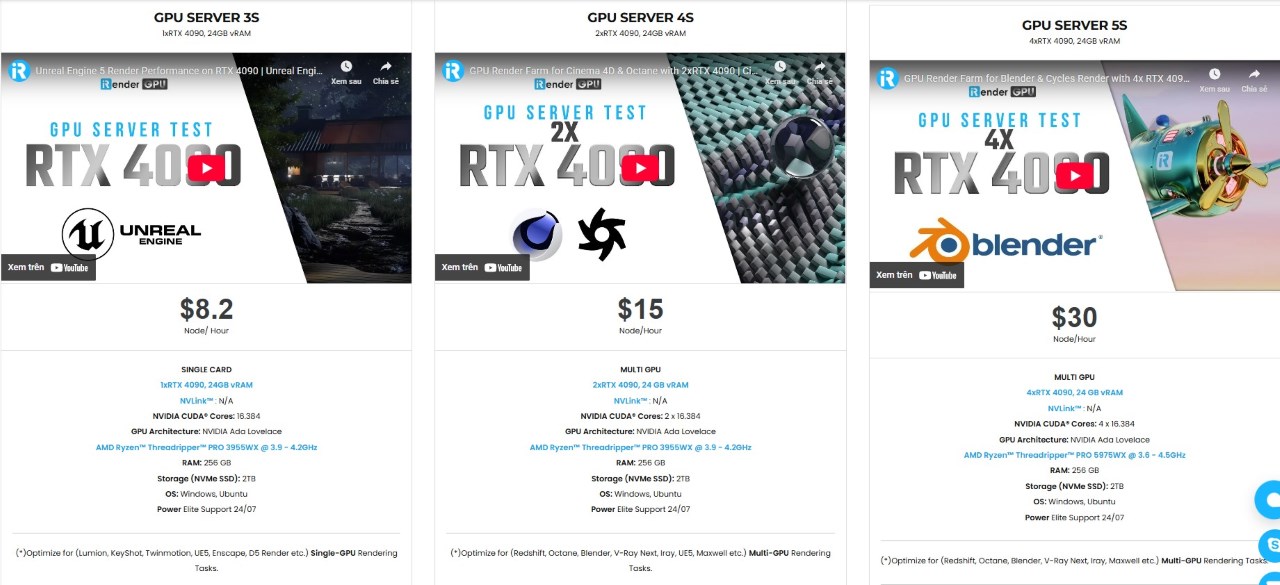
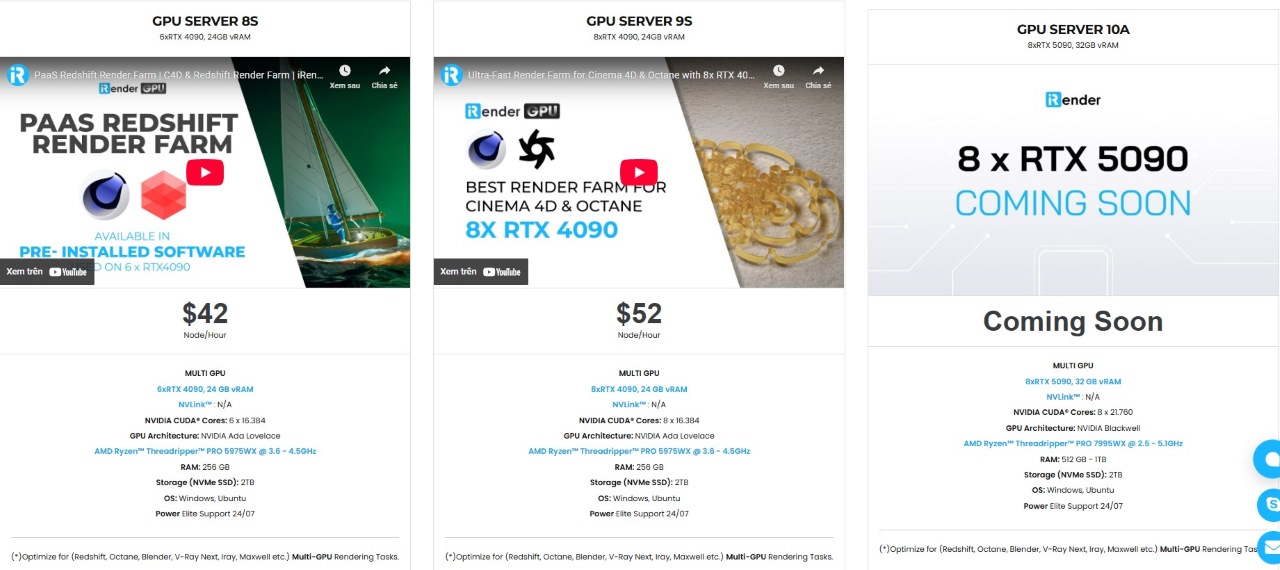
Fox Renderfarm Price
Fox Renderfarm is a fast and secure cloud render farm. They offer massive render nodes and multiple 3D software package support. Fox Renderfarm supports both CPU and GPU rendering, so there are two prices.
CPU Price
CPU pricing is based on core hours. You can multiply the unit price by the number of physical cores.
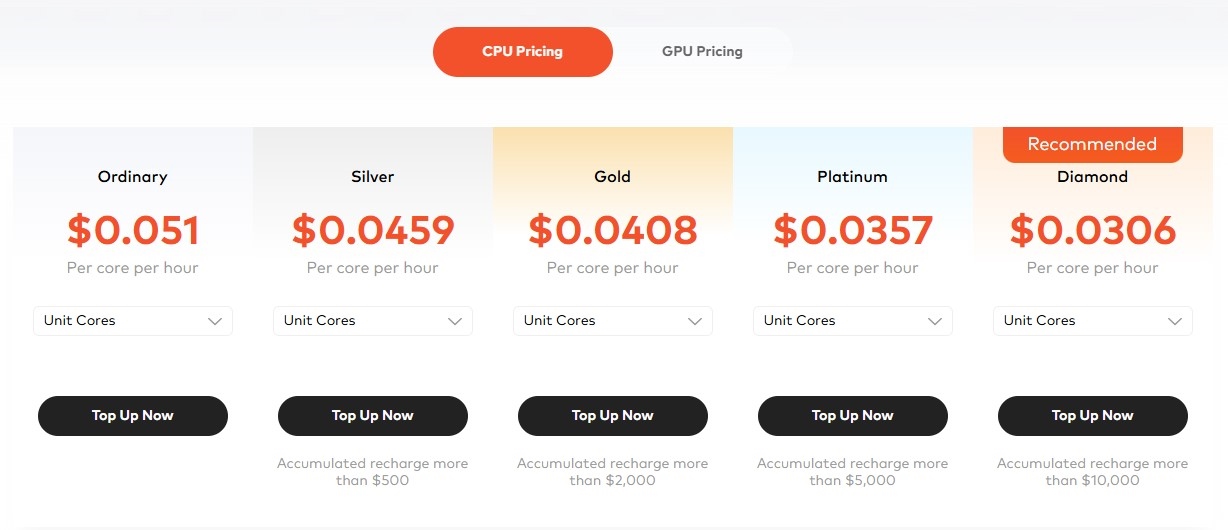
GPU Price
Fox uses node hour unit for GPU pricing. However, the default GPU unit price is based on 2 GPU nodes. So, if you render on a single GPU node, the price is half of the default price, while the price of the 4 GPU nodes is double.
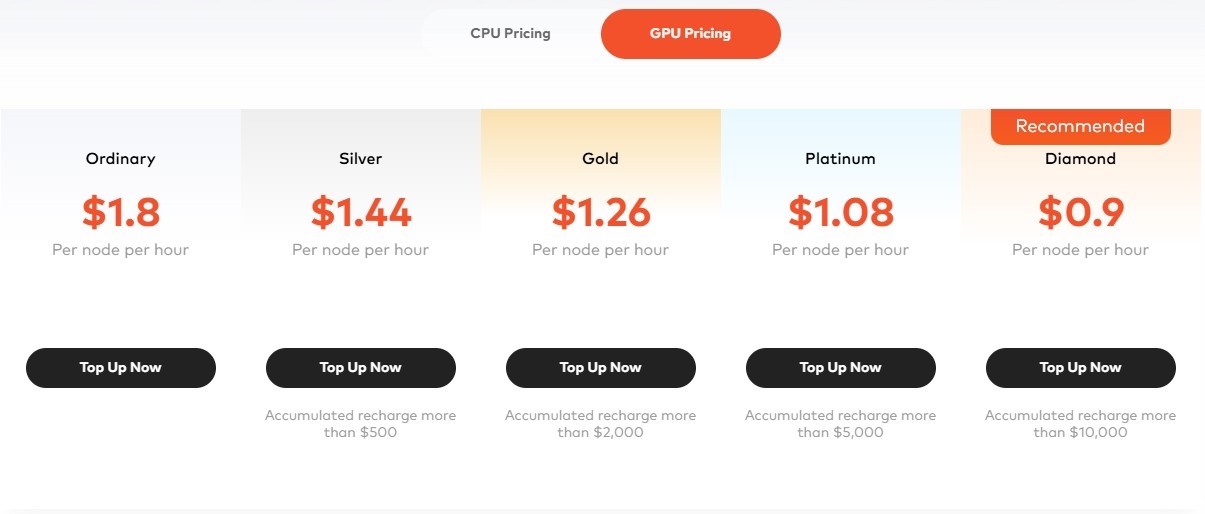
GarageFarm Price
GarageFarm is a fast and reliable render farm service. Supporting a wide range of 3D software & plugins as well as offering professional tech support is their strength. Further, GarageFarm provides both CPU and GPU render services.
While iRender is the only farm using GPU pricing, Garage Farm is the only render farm that lists both GHzH/Obh and node hour prices for their services. Well, it seems there are 4 prices. But actually, there are two: GHzH and node hour for CPU nodes whereas Obh and node hour for GPU nodes. We have explained the reason above, we easily convert GHzH/Obh pricing into node pricing, and vice versa, as long as we know the specific configuration of the CPU or GPU node.
Another thing is that similar to iRender, GarageFarm has quite clear node specifications.
CPU Price
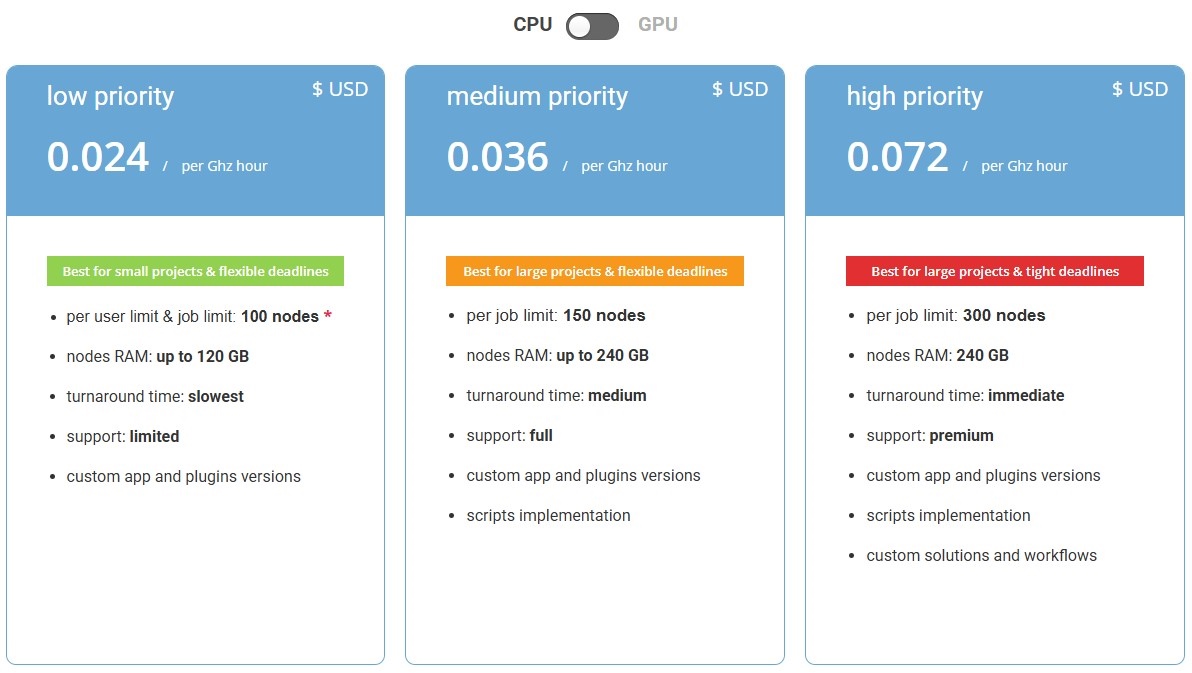
GPU Price
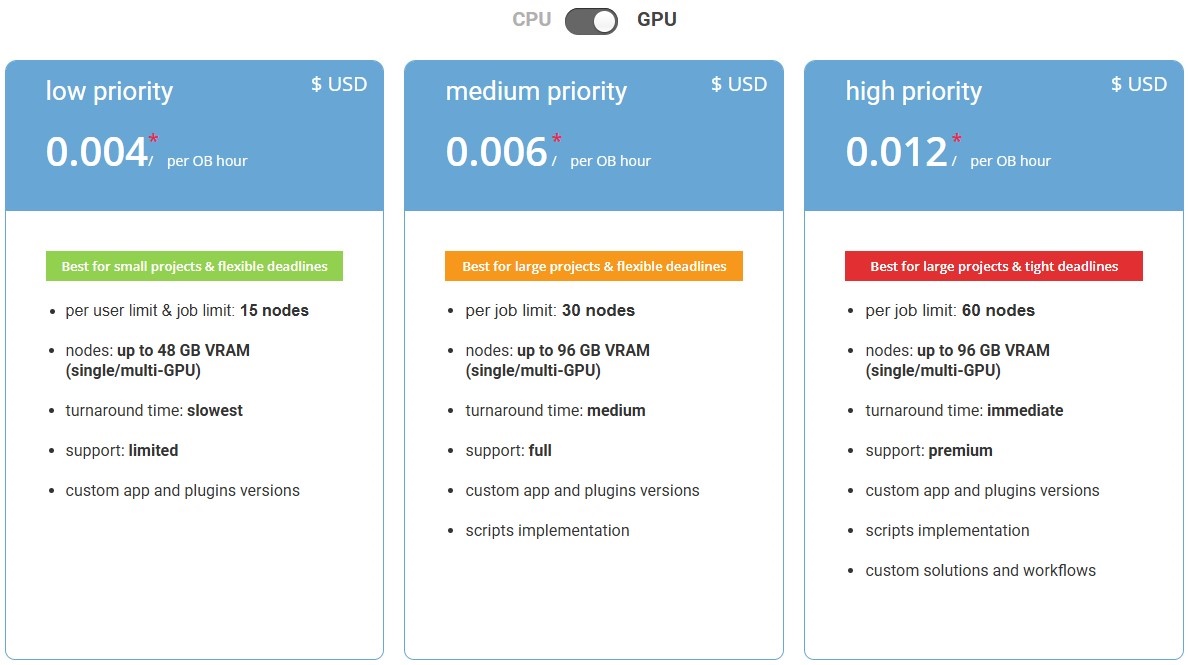
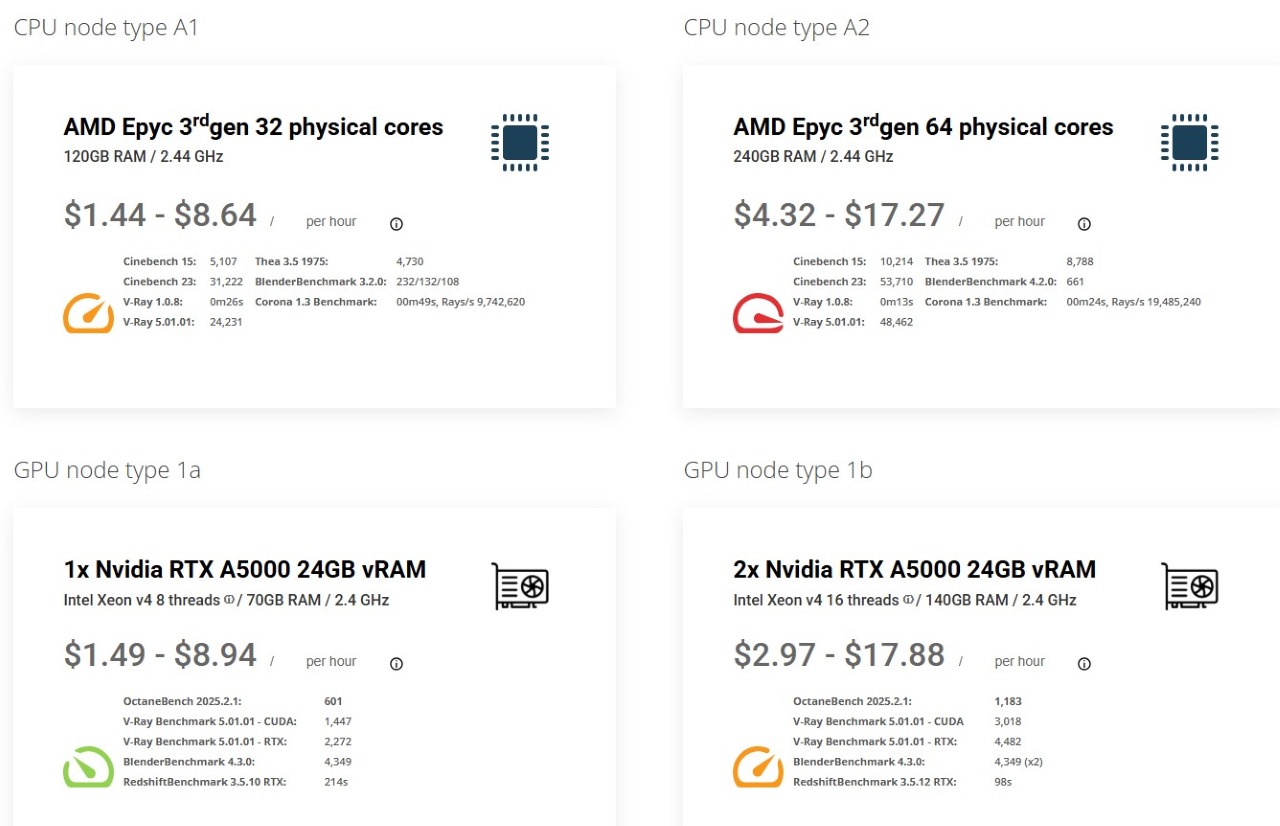
RANCH Computing Price
RANCH Computing is a powerful render farm. They support many industry-standard software and a huge number of renderers and plugins. RANCH Computing is both CPU and GPU renderfarm. So, there are two prices.
CPU Pricing of RANCH is in GHzH while GPU Pricing is in Obh.
CPU Price
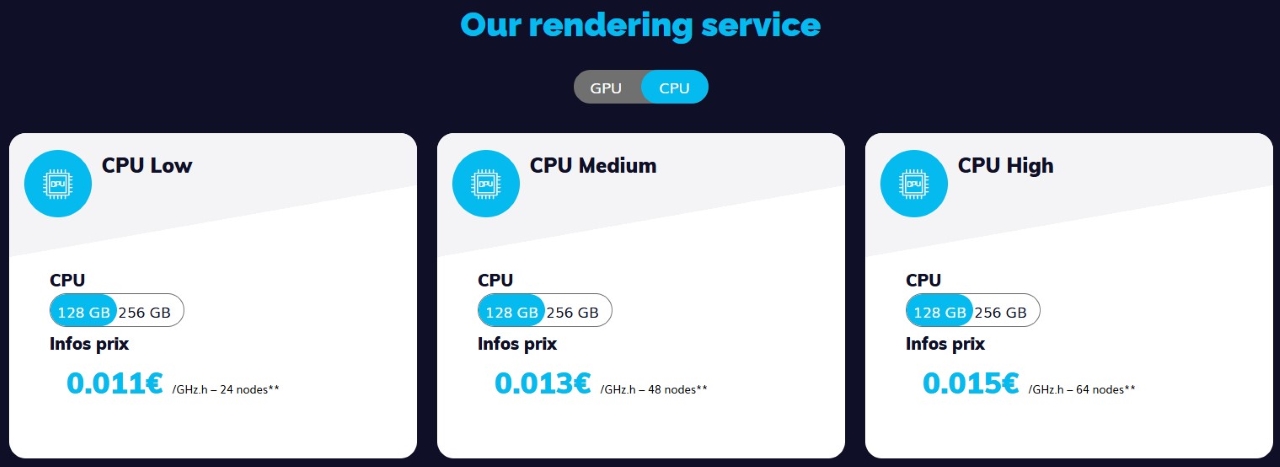
GPU Price
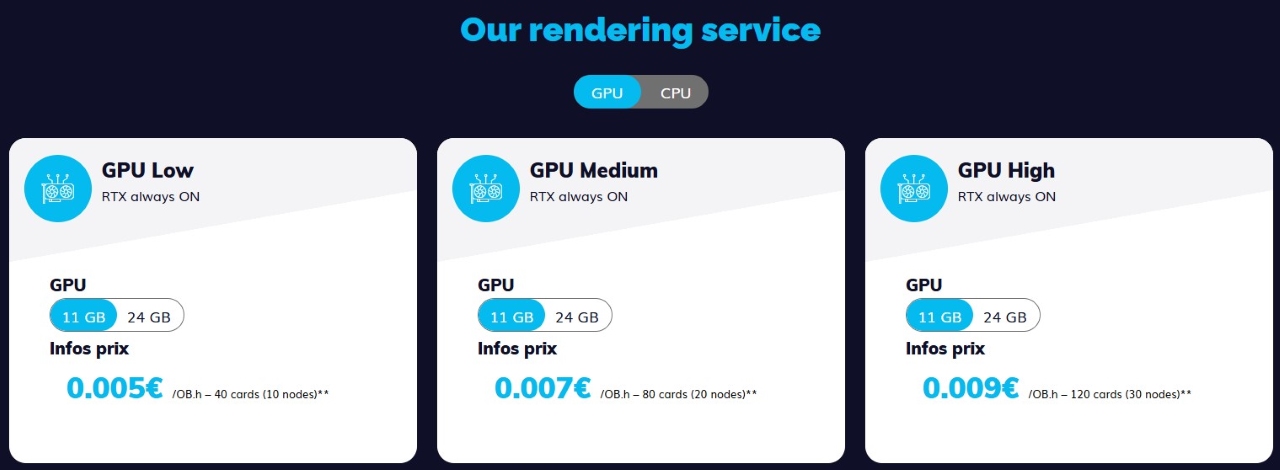
RebusFarm Price
RebusFarm is a trusted CPU and GPU render service. They support many common 3D software and plugins. Same as GarageFarm and RANCH Computing, RebusFarm offers GHzh price for CPU rendering, and Obh price for GPU rendering.
CPU Price & GPU Price
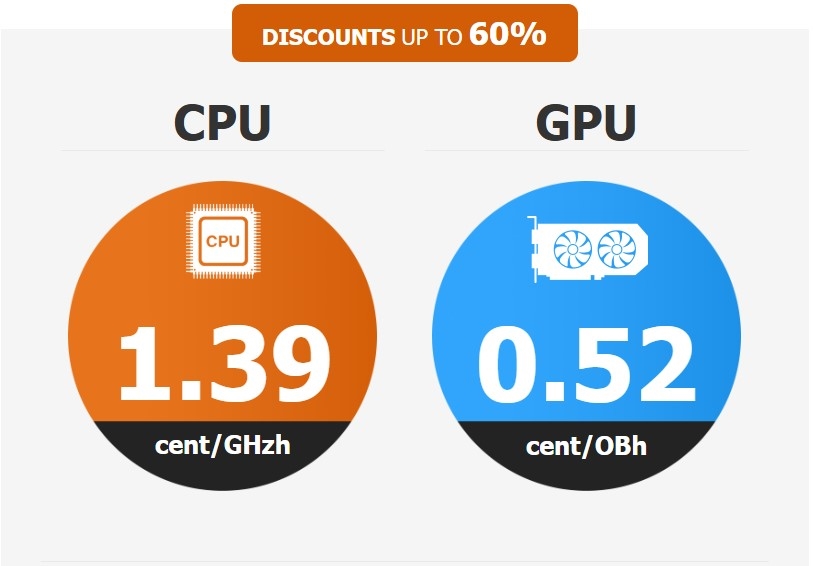
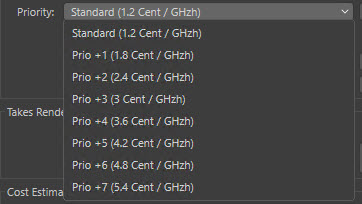
CPU price 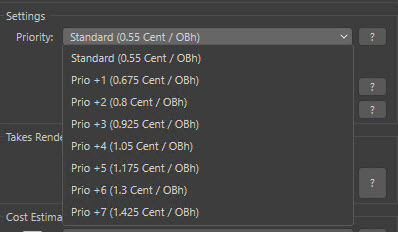
GPU price
What is the best render farm price?
Even though each render farm uses different pricing methods to calculate the rendering cost, we are able to convert them into one unit somehow. (Provided that we know the CPU or GPU model of the nodes). The problem here is that some render farms do not show the configuration of their render farm machines. So we have no clue to compare.
Even if we manage to change to the same pricing unit, for example, GHzH for CPU rendering, and Obh for GPU rendering. Do you think that you can compare prices between render farms and choose the cheapest one now? Maybe. But not 100%.
Why is that? It is because of different hardware (sometimes different software versions or benchmarking tools). A render farm with a more powerful GPU surely has a higher GPU price, but not necessarily a higher render cost. Because more stronger GPU will render scenes faster and deliver better quality. The same applies to CPU render farms.
So, how do compare prices now? The better solution is to make your own test. Just simply send some frames to a few render farms you want to try. Not only do you get a better cost estimation but also check the quality and avoid possible issues.
Conclusion
Hope this article helps you get a better understanding of render farm price and how it works. Yet, running tests is the best way to estimate cost and compare between render farms. VFXRendering has used and done a few tests on our Best Render Farms.
See more:



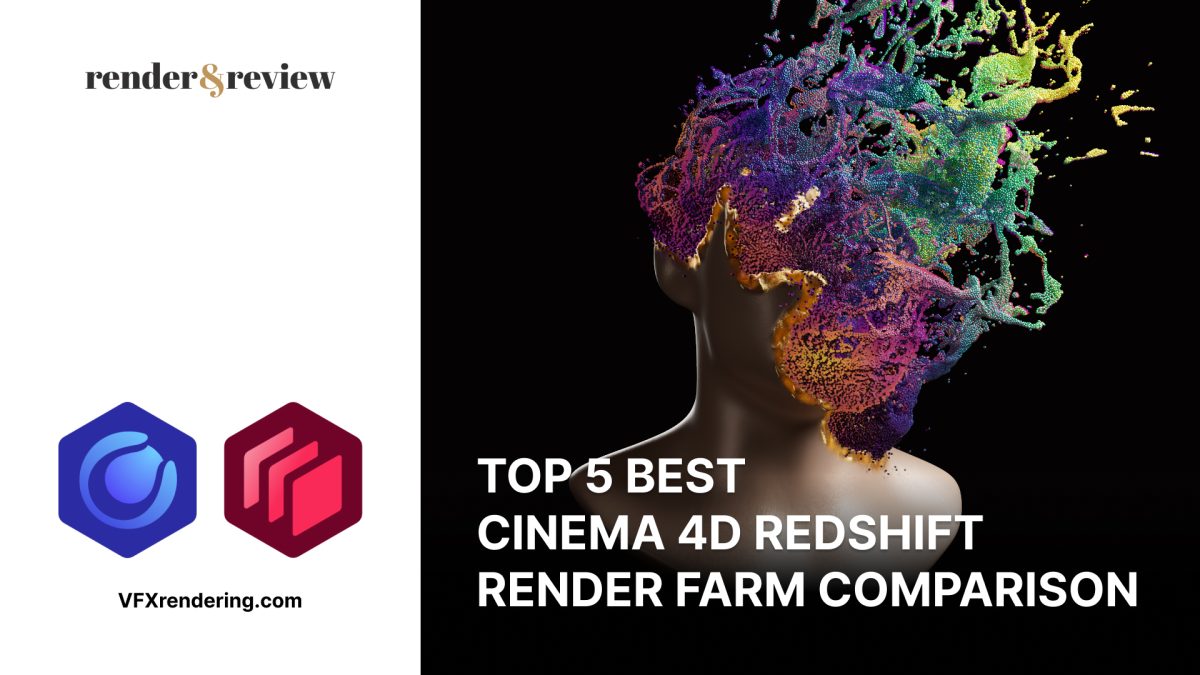
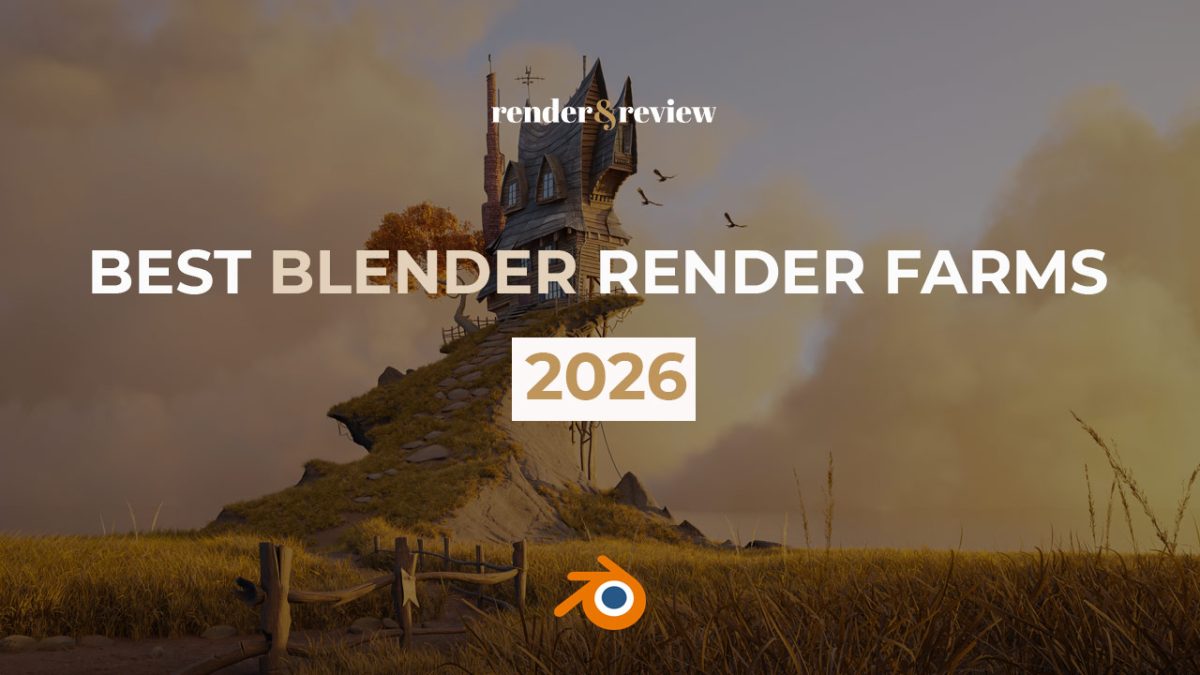
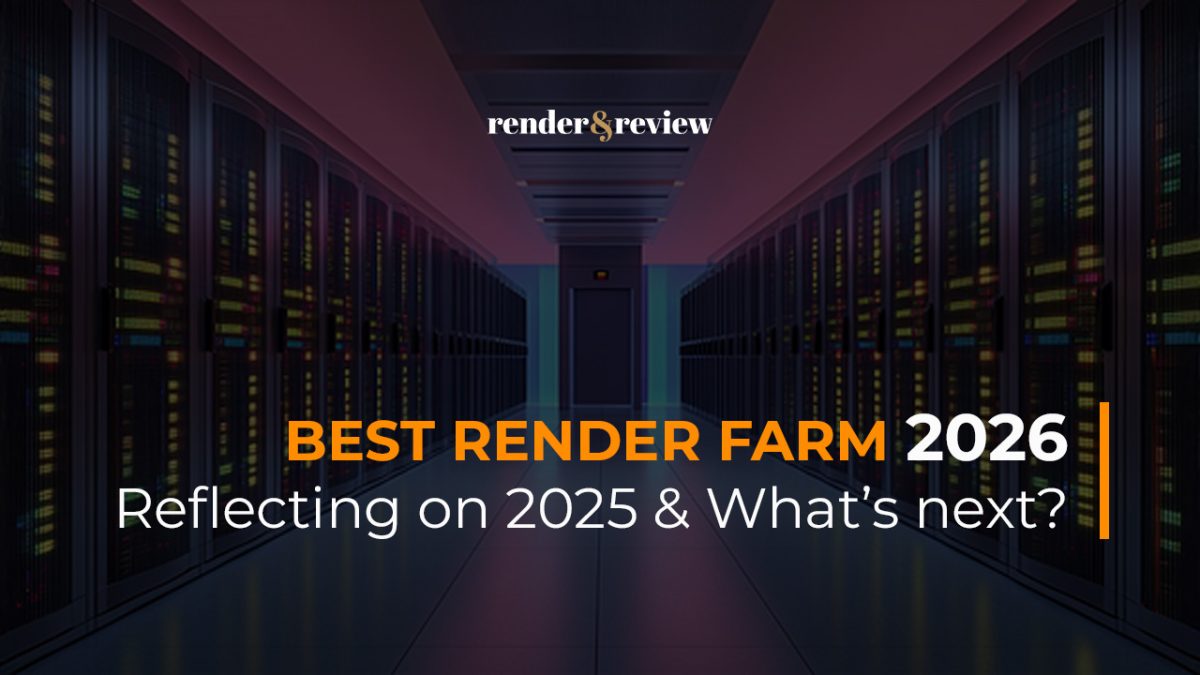


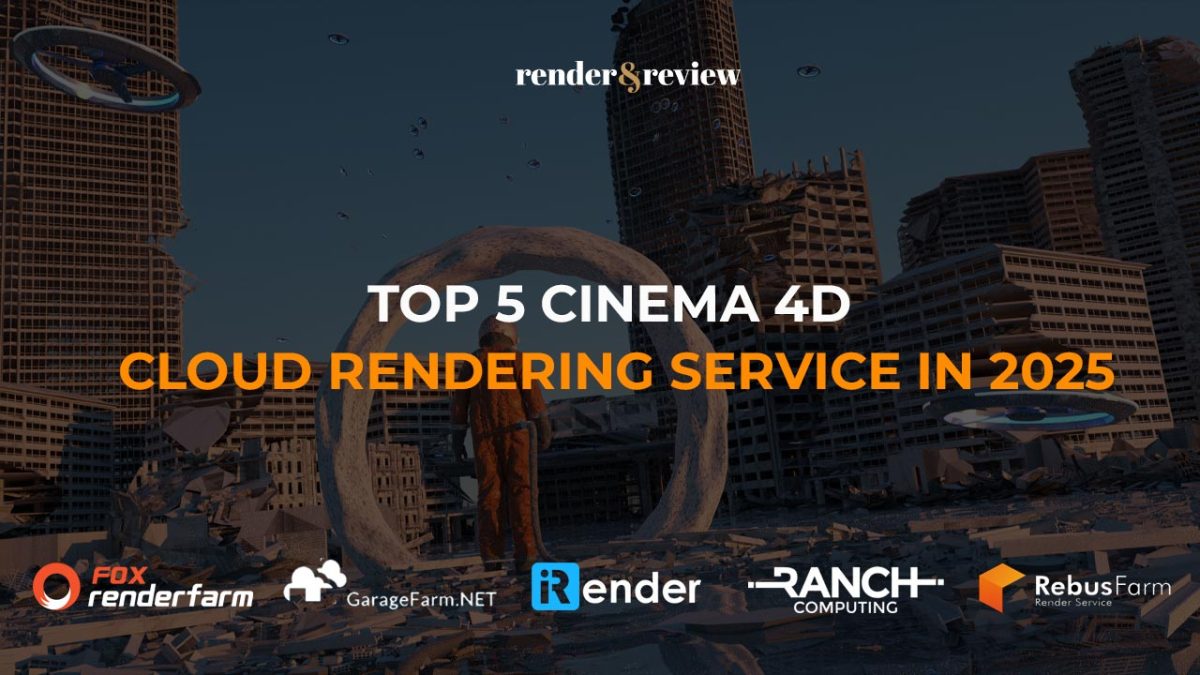
No comments